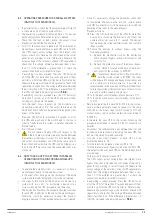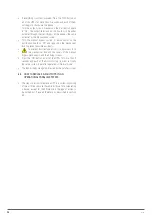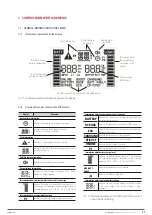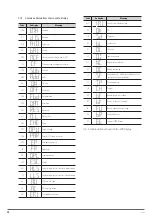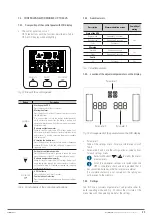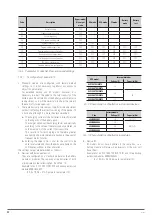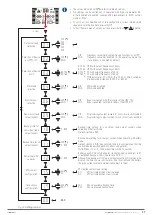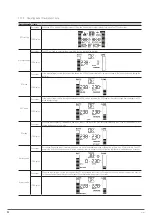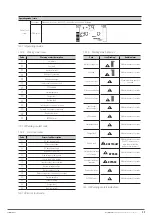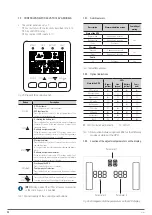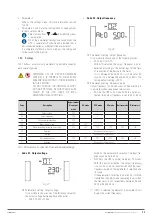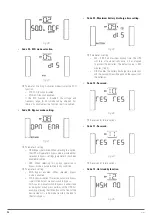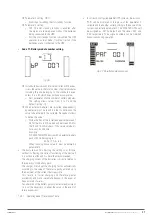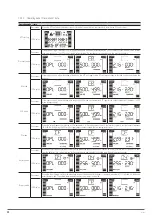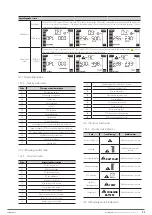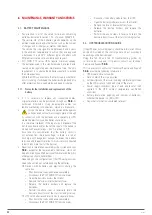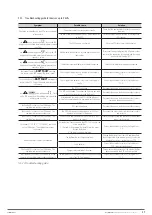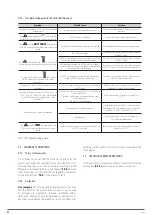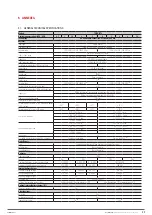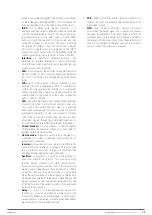
30
SALICRU
Code
Description
Bypass mode/
No output
mode
AC mode
ECO mode
CF mode
Battery
mode
Battery
test
01
Output voltage.
YES
-
-
-
-
-
02
Frequency converter state.
YES
-
-
-
-
-
03
Output frequency.
YES
-
-
-
-
-
04
ECO enable/disable mode.
YES
-
-
-
-
-
06
Bypass state (UPS ‘Off’).
YES
YES
-
-
-
-
09
Programmable output state.
YES
YES
YES
YES
YES
YES
10
Programmable output configuration.
YES
YES
YES
YES
YES
YES
11
Backup limitation configuration.
YES
YES
YES
YES
YES
YES
12
Total battery pack Ah configuration.
YES
YES
YES
YES
YES
YES
15
EPO logical configuration.
YES
YES
-
YES
YES
-
17
Viewable backup time configuration.
YES
Tab. 8.
Parameter 1 codes list. Description and settings
7.2.4.1. Ah configuration of parameter ‘12’.
•
Standard models are configured with factory default
settings, so it is not necessary to perform any actions to
adjust this parameter.
For extended backup and B1 models, however, it is
necessary to adjust the value to the total capacity of the
battery pack. Any alteration of the battery pack will entail a
readjustment, so it will be necessary to adapt the value in
the event of future expansions.
•
There are basically two reasons to perform the adjustment
without it affecting the correct functioning of the device if it
is not done, although it is more than recommended:
a.
The charging current of the batteries is directly related
to the capacity of the battery pack.
The charger will adapt the charging factor automatically
according to the value of the total capacity entered, up
to the maximum of the current that is possible.
This results in faster charging and therefore greater
availability and more immediate backup in the event of
frequent mains failures.
b.
Entering the value in Ah is vital for the control to be
able to calculate and show the backup available on the
LCD display, without further alterations.
The settings values are determined as follows:
1.
Devices with backup extension.
They are configured by a standard model plus the battery
module or modules. The capacity of the batteries of both
are indicated in the following Tab. 9 and Tab. 10.
Example for an SLC 1500 TWIN RT2 and backup extension
module 698BU000003:
9 Ah + 18 Ah = 27 Ah (value for parameter 12).
UPS model
Internal batteries
Voltage (V)
Capacity (Ah)
SLC 700 TWIN RT2
36
7
SLC 1000 TWIN RT2
SLC 1500 TWIN RT2
48
9
SLC 2000 TWIN RT2
SLC 3000 TWIN RT2
72
Tab. 9.
Characteristics of batteries in standard devices.
Battery module
Code
Voltage (V)
Capacity (Ah)
698BU000001
36
14 (2 x 7)
698BU000002
36
18
(2 x 9)
698BU000003
48
698BU000004
72
Tab. 10.
Characteristics of batteries in modules.
2.
Device B1.
B1 models do not have batteries in the same box, so a
battery module will always be necessary or the user will
have them.
Example for an SLC 1500 TWIN RT2 B1 and three backup
extension modules 698BU000003:
(3 x 18 Ah) = 54 Ah (value for parameter 12).










